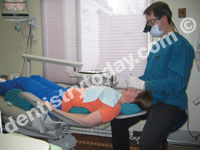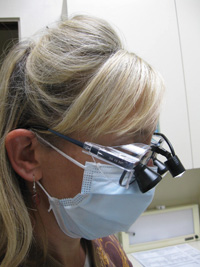Prior to 1985, low back pain was the most commonly reported musculoskeletal disorder (MSD) or repetitive injury for dentists and dental hygienists. Since then, there has been a rise in MSDs from extended workdays, awkward postures, prolonged standing/unsupported sitting, and a host of other problems caused by poorly designed workstations, improper work habits, and instruments that are difficult to manipulate. The current workstation in most dental offices requires that the practitioner lean forward, flex his neck forward and laterally, hold his shoulders abducted and his arms flexed, with this position being held statically for most of the workday. Dentists need to tightly grip thin, sharp instruments and make a high volume of short, forceful movements with the muscles of their wrists and hands to treat heavy calculus and other conditions. The human body is not built to handle these kinds of stresses, and the positions in which dentists repeatedly put themselves through their work place them at great risk for developing MSDs.
Repetitive strain injuries are on the rise in dentistry. Many dentists/dental hygienists have been diagnosed with a MSD, and a majority have experienced some type of musculoskeletal pain in their shoulders and neck, hands and wrists, low back, or forearms and elbows. More studies need to be conducted on the impact of dental work on the development of nerve and muscle pathologies, which would prevent dentists from providing the highest quality of service and could threaten their professional careers.
These injuries result in costly insurance payments, extended periods of time away from work, and decreasing work performance, job satisfaction, and energy levels. For many dental practitioners, musculoskeletal pain and the development of repetitive strain injuries have caused them to take a leave of absence, shorten their work hours, reassign their duties to other dental staff, or undergo surgery, and some dentists have been forced into premature retirement. Until recently, this problem has not been given much attention, but with increasing numbers of dentists developing painful symptoms, changes must be made to the way they practice to allow for longevity in their careers.
The good news is that these problems can be avoided by increasing awareness of the postures used during work, redesigning the workstation to promote neutral positions, examining the impact of instrument use on upper extremity pain, and following healthy work practices to reduce the stress of dental work on the practitioner’s body. These topics will be covered as part of a two-article series that will answer many of your questions about how to incorporate ergonomics into your dental practice to prevent the development of MSDs and repetitive strain injuries. This article introduces you to MSDs and the signs, symptoms, and risk factors of these types of injuries, so you can be aware of developing problems and can change your approach to your work or alter your workstation setup to prevent further injury. The article also discusses the important issue of posture and offers 10 ways to improve your posture to allow you to work with comfort, efficiency, and ease.
WHAT IS A MSD?
| Table. Understanding MSDs |
|
Some Signs of MSDs Some Symptoms of MSDs Some Risk Factors for MSDs Off-the-Job Activities That Can Contribute to MSDs |
A MSD is an injury of the muscles, nerves, tendons, ligaments, joints, cartilage, blood vessels, or spinal discs. These disorders can occur from a single incident, such as lifting a heavy weight, or can develop gradually from repeated stress on a part of the body. MSDs can affect any part of the body, but most commonly occur in the back, neck, shoulder, elbow, and wrist (Table).
WORKSTATION SETUP
The workstation setup is vitally important because it determines the postures that must be taken and sustained by the dentist when working on patients and how the practitioner must reach to retrieve the necessary instruments. The workstation is composed of the dentist’s/dental hygienist’s chair, the patient’s chair, the delivery system, and the cleaning/charting area. When the workstation is set up improperly or is not adjusted to the individual dentist’s dimensions, it can cause the dentist to put excessive stress on his/her body with each movement, and these positions are repeated throughout the day. By being aware of what causes you to assume harmful postures, you can begin to work on correcting any misalignments needed to put yourself in the proper posture to perform your work effectively.
Some Elements of an Improper Workstation Setup
Improper workstations may include the following:
•Dentist’s or patient’s chair is too high/low.
•Dentist’s chair has no lumbar, thoracic, or arm support.
•Instrument table is not positioned properly.
•Lighting is inadequate for the task.
•Edges of tables/worksurfaces are sharp/uncomfortable.
•Ventilation makes workspace cold.
•Work environment is damp and cold.
THE IMPORTANCE OF POSTURE
The elements of an improper workstation setup force the dental practitioner to assume many harmful postures when performing various procedures on the patient. These positions put pressure on nerves and blood vessels, cause excessive strain on muscles, decrease circulation, and cause wear and tear on the joint structures. When you notice yourself working in awkward positions, you should change positions and assume healthy, ergonomic postures to avoid injury.
Some Improper Postures That Dentists Take
Improper posture may include:
•Working with neck in flexion/tilted to one side.
•Shoulders elevated.
•Side bending to left or right.
•Excessive twisting.
•Forward bending/overreaching at waist.
•Shoulders flexed and abducted.
•Elbows flexed greater than 90°.
•Wrists flexed/deviated in grasping.
•Thumb hyperextension.
•Position maintained for 40+ minutes per patient.
Some Tips for Working With Good Posture
(1) Always try to maintain an erect posture. By positioning your chair close to the patient, you can minimize forward bending/excessive leaning over the patient. Keep your feet flat on the floor to promote a neutral or anterior tilt to your pelvis, which keeps your back aligned and promotes the natural curvatures of your back. Remember that your head weighs as much as a bowling ball, and when you lean forward and flex your neck, you force your muscles to hold up the weight of your head, rather than the bones and discs in your spine.
(2) Use an adjustable chair with lumbar, thoracic, and arm support. Having a good chair is essential in maintaining good posture, because what you sit on provides the base of support from which you work all day long. When you think about it, you work 8 or more hours per day, 5 days per week, 4 weeks per month, and about 11 months out of the year, which makes a high-quality chair with adjustable features well worth the cost of saving your back, neck, arms, and hands. You should look for important features like adjustable height, width, tilt, backrest, seat pan, and armrests, because in most dental offices many people of different sizes use the same workstation.
(3) Work close to your body. Position your chair close to your patient, and position your instrument tray close to you. This way, you don’t have to overextend yourself to reach your patient or your instruments, putting excessive stress on your back, shoulders, and arms. Think of the 90° rule of having your elbows, hips, knees, and ankles all forming 90° angles. If you find yourself reaching out far beyond these angles too often, then you’re not properly positioned and you should adjust the position of your chair/instrument tray.
(4) Minimize excessive wrist movements. Be conscious of how you position and move your wrists, and try to keep them in a neutral position (palms facing each other, shoulder width apart with wrists straight), which puts your muscles and tendons in a much better relationship to perform the work. You will have to move your wrists into various positions as you work on your patients, but try to be aware of these movements so you can minimize potentially damaging hand positions.
(5) Avoid excessive finger movements. When you combine the excessive forces needed to hold your instruments with the amount of repetitions that you perform each day, you can see the tremendous toll that this takes on the small muscles of your fingers. Retrain yourself to use your shoulders and arms to position your hands, rather than making the small, forceful movements with your fingers.
(6) Alternate work positions between sitting, standing, and side of patient. Switching positions allows certain muscles to relax while shifting the stress onto other muscles and increasing your circulation. When you work on alternate sides of the patient or rotate the position of your instrument table, you allow each side of your body to share the stress, rather than performing the same motion in the same way, which causes cumulative trauma in the overused side.
(7) Adjust the height of your chair and the patient’s chair to a comfortable level. If your chair is too low and the patient’s chair is too high, this causes you to elevate your shoulders and can lead to neck problems and pinched nerves. Alternately, if your chair is too high and the patient’s chair is too low, you’ll have to flex your neck down and bend your wrists back to compensate, which can lead to neck and hand problems. Remember the 90° rule and keep your elbows at a 90° angle with your wrists straight and shoulders relaxed.
(8) Consider horizontal patient positioning. If your workstation allows the patient to be reclined into a horizontal position, this allows you to sit above the patient’s head with good ergonomic posture, and you can use each arm equally in more natural positions. If the workstation does not accommodate this position, consider buying a quality reclining chair for the patient when you replace the old one.
(9) Check the placement of the adjustable light. Position the adjustable light so you don’t have to strain your neck to be able to see in the patient’s mouth. It is important to adjust this light with each new patient because of the different height of each person. The light should be adjusted again when a new dentist uses the workstation because his/her sitting eye height is different, and this will affect his/her ability to see into the patient’s mouth.
(10) Check the temperature in the room. Make sure the temperature in your workspace is not too cold because this will decrease the circulation and blood flow to your extremities. Most often, the dental work environment is damp and cold, so be certain to wear gloves and warm up your hands before working on a patient.
CONCLUSION
Begin to make some changes in the way you practice by incorporating some of these suggestions into your regular routine during the work day. You will find that you have less fatigue at the end of the day, you will experience less pain, and you will be able to provide the quality of service that you and your patients demand.
The second part of this article will address the various work practices that dentists perform, the risk factors, and suggestions to make them more hand friendly. Instrument use will be examined, and suggestions will be made to counteract the inherent dangers in using the instruments involved in dental work. Finally, recommendations for maintaining personal health, stress management techniques, as well as exercises and stretches will be covered to promote productivity and health over the life of your career.
Mr. Graham is an occupational therapist, hand therapist, and ergonomist who specializes in reducing the incidence and severity of repetitive strain injuries in dental offices in the San Francisco Bay Area. His company, Employee Ergonomic Services, provides injury prevention seminars, workstation evaluations, and ergonomic training for dentists to improve posture and efficiency and reduce costly injuries that threaten the livelihood of the dental practitioner. To earn continuing education credits while attending an on-site seminar, please contact Mr. Graham at (415) 821-3264 or colin@employeeergonomics.com. The seminar involves a PowerPoint or overhead presentation, problem-solving sessions, ergonomic workstation evaluations, demonstrations, and recommendations specific to the dental practitioners and hygienists, and it can be offered nationwide.











